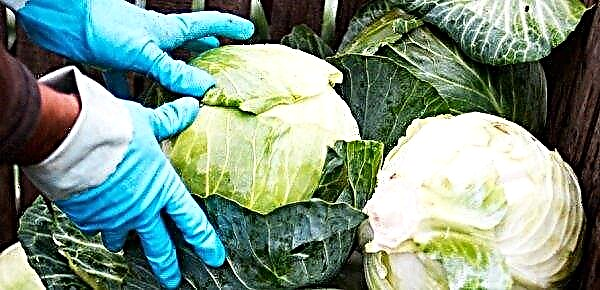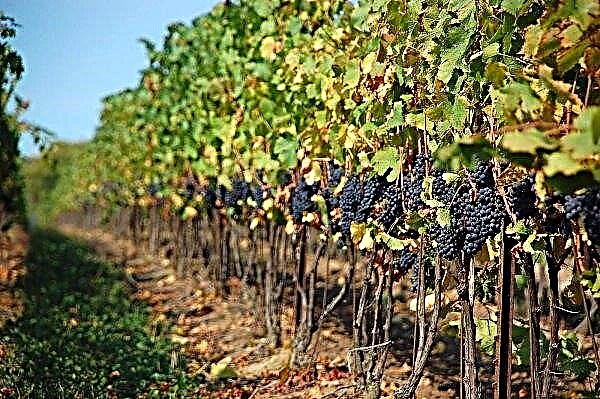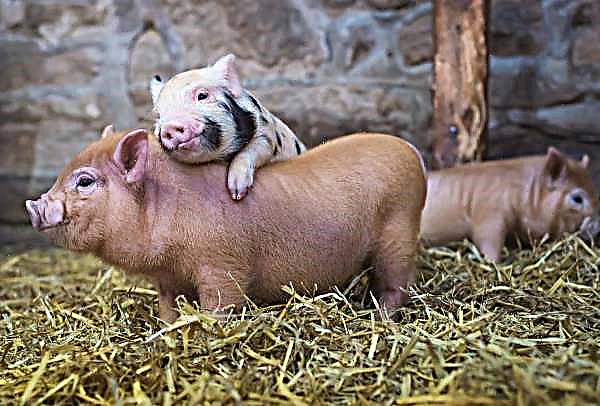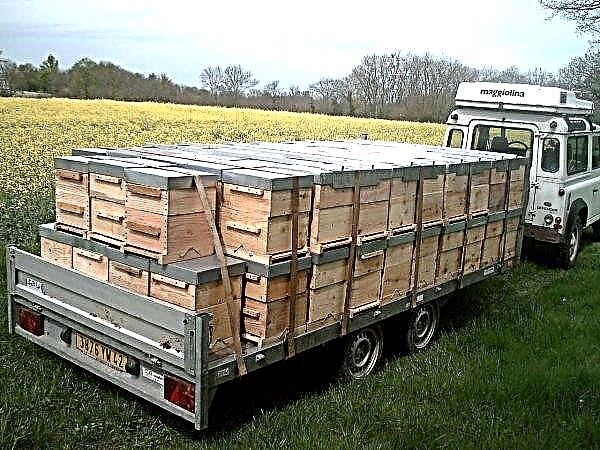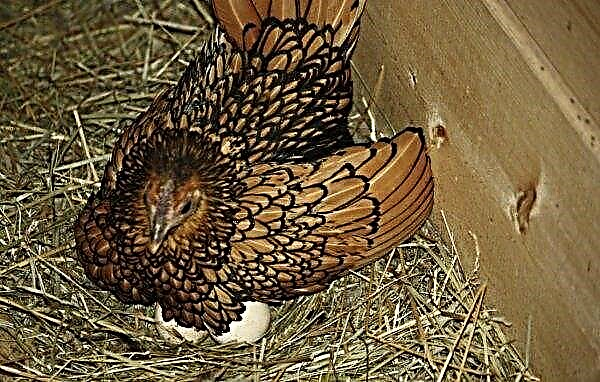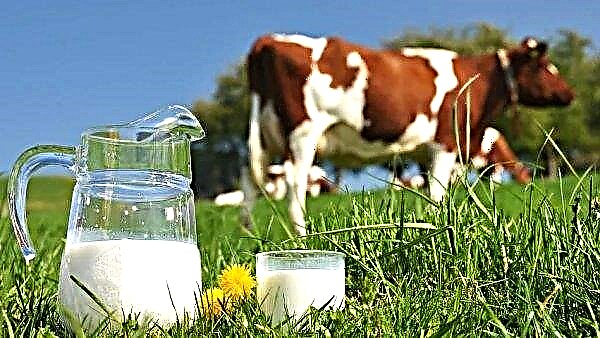Diseases and pests adversely affect the growth and development of plants, causing damage to them, which often cause deformation of the leaves, stems, disrupt the nutritional process of a living organism and jeopardize their fertility. In this article, we will talk about peronosporosis of cucumbers or, as it is also called, downy mildew.
What is peronosporosis on cucumbers
This disease occurs as a result of spores of the fungal pathogen Peronospora getting into the cucumber bush in high humidity conditions. Zoospores are aggressive in nature and have a tendency to rapidly multiply and spread, introduce plants into a living organism.
The mycelium is actively growing and soon the first signs of infection with a fungal disease begin to form in the form of white-gray, sometimes with a purple tint, spots with a light fluff.
Did you know? More than 6 thousand years ago, people first began to eat cucumbers. Mention of them can be found in Egyptian letters confirming that this vegetable was placed in the tomb of the pharaoh.
In addition to the fact that fungal spores independently successfully reproduce, pests such as aphids and whiteflies also contribute to the process of increasing their numbers.
Causes and signs of occurrence
Signs that signal infection with peronosporosis are as follows:
- the appearance of spots with a slight edge of white, light gray, light purple;
- change of spots with a gun to oily stains of light shades of yellow on the outside of the leaves (spots are characterized by a limited distribution area by leaf veins);
- increased stain growth at high speed;
- the color of the leaf plate from green to brown as a result of impaired photosynthesis, its gradual withering and drying;
- after the death of the leaves there is a violation of the formation and ripening of cucumbers.
On cucumber bushes, the manifestation of peronosporosis can most often be seen in late summer - the period when daily temperature fluctuations become more noticeable and condensation on the leaves can be noticed in the open ground in the morning. This ailment often occurs in a greenhouse, in conditions of insufficient ventilation.
In winter, the spores of this fungus do not die, but go into a dormant state, being in the remains of infected and dead plants, in their fallen leaves and stems remaining in the ground. Thus, infection of the fertile soil layer and the spread of fungal spores with the help of wind and rain.
So zoospores travel, infecting more and more living organisms. However, in dry and hot weather, the activity of the zoospores fades, but they still remain alive.
Among the factors contributing to the infection with downy mildew, it is worth highlighting the following:
- high humidity, rain;
- dewdrop, nebula;
- watering with cold water;
- moisture accumulation on the walls of the greenhouse as a result of a disturbed ventilation system;
- heap landing;
- abundance of weeds around a vegetable planting.
 The taste characteristics of cucumbers grown on a bush infected with peronosporosis significantly deteriorate, as well as their shape and weight, due to a violation of the nutrition system of the whole plant organism during fruiting. However, the disease does not affect the fruits themselves.
The taste characteristics of cucumbers grown on a bush infected with peronosporosis significantly deteriorate, as well as their shape and weight, due to a violation of the nutrition system of the whole plant organism during fruiting. However, the disease does not affect the fruits themselves.Did you know? Spines on fresh and young cucumbers perform the function of removing excess moisture from a vegetable.
Treatment and measures to combat peronosporosis
To eliminate peronosporosis, it is necessary to develop a clear plan of measures for its elimination, explaining what to do to get rid of this dangerous fungus and how to proceed in order to prevent it from returning to the garden and not to risk other cucumber bushes and other vegetable crops at risk of infection:
- treatment of diseased bushes with medicinal preparations;
- compliance with growing conditions;
- prevention of the spread of an existing threat and preventing the appearance of fungus on healthy bushes.
As soon as an attentive farmer finds the first signs of peronosporosis, described above, measures must be taken to eliminate it:
- Trim all leaves and processes that are already damaged by the fungus, and burn them all without fail. If this condition is not met, then the chance of re-infection is very high, since the spores of the fungus remain in the soil, as well as the cut off processes of the diseased plant.
- To save the crop, when the disease has not yet attacked the plant, fungicides are used in a concentration corresponding to the stage of development of peronosporosis.
- After harvesting, the soil is disinfected with chemicals in order to destroy the fungus, and a soil layer 5-7 cm thick is removed.

Effective drugs
In the fight against peronosporosis, such agents are actively working:
- sulfur solution, which is prepared by dissolving 50–80 g of a chemical substance in a bucket of water;
- Bordeaux liquid, for the preparation of which 100 g of copper sulphate and hydrated lime are used, dissolving them in 10 liters of warm water;
- fungicides;
- combined fungicides.
The most popular fungicides include:
- "Fitosporin";
- Fitosporin-M;
- "Gamair";
- Planriz;
- Alarin-B;
- "Gliocladin";
- "Gates";
- "Quadrice";
- "Acrobat MC";
- "Ordan";
- Ridomil.
Combined fungicides:
- copper oxychloride;
- "Ridomil Gold";
- Efal.
 For example, processing “Fitosporin” of cucumbers in the open field consists in watering with an aqueous solution with a diluted powder preparation. Such treatment is preventive in nature and should be done twice a month.
For example, processing “Fitosporin” of cucumbers in the open field consists in watering with an aqueous solution with a diluted powder preparation. Such treatment is preventive in nature and should be done twice a month.An effective measure to prevent infection with peronosporosis is also the treatment of seeds before planting in the ground. The procedure is as follows: the seeds are dipped in a hot liquid with a temperature of + 50 ° C for a quarter of an hour. They can also be treated with special chemicals containing metalaxyl (mefenoxam), in accordance with the dosage on the package.
Important! Excessive use of fungicides causes accumulation of pesticides and harmful substances in the fruit.
The use of special drugs is carried out every two weeks. A month before the start of the harvest, the use of fungicides is completed and they are switching to the use of folk remedies.
Folk remedies
Experienced gardeners have a lot of folk methods to eliminate this fungal disease, some of them are presented below:
- If the initial signs of the disease are found on the bush, then onion husk infusion can be used effectively, which is prepared from 200-300 g of the main component, poured with a bucket of water, which then must be put on fire and bring the mixture to a boil. Then the liquid is sent to cool and infuse for 2 days. Before use, it can be filtered.
- Treat with a solution of 1 liter of skim milk in 9 liters of water with the addition of 10 drops of iodine 5%.
- A solution of brewed ash diluted in 10 liters of water is used to spray the bushes. In order to brew the ash, it is necessary to take it in a volume of 2 glasses and pour 3 liters of boiling water, let it brew and strain through several layers of gauze.
- The potassium permanganate solution is also effective. For its preparation use 1–1.5 g of potassium permanganate per 10-liter bucket of water.
- To destroy the mycelium, you can use a tool based on manure. To prepare it, you need to part 1 part of cow manure in 3 parts of water, insist the resulting solution for 4 days and strain. The resulting concentrate is diluted in 7–8 L of water and used to spray foliage every 1–1.5 weeks in the evening.
- Alkaline solution is also effective in the process of destroying this fungus. To prepare it, make a mixture of 25 g of soda and 5 g of liquid soap, and then dissolve in 5 l of hot water. After cooling with a solution, both the plant itself and the top layer of the earth are sprayed. This procedure must be repeated 2 weeks after the first spraying.
- Effectively apply the method of processing cucumbers with greens. It is added to spraying water in accordance with the following technology: 1 liter of skim milk is added to 9 liters of water, then 10 drops of brilliant green are added. The use of the substance lies in its antiseptic effect and high copper content. In addition, this therapeutic agent can be used not only to eliminate downy mildew, but also to combat other diseases, as well as to prevent and fertilize them. Cucumbers after using zielonki gain good product characteristics, a more saturated color.

Preventive measures
The protection of vegetables begins with the implementation of preventive measures that involve the following actions:
- regular inspection and monitoring of the condition of the bush;
- control of soil conditions and growing conditions;
- preventive treatment of the soil and the plant itself.
Preventive agricultural measures for the care of the bush include:
- maintaining the necessary level of humidity, preventing excessive watering;
- control the appearance of moisture drops in greenhouse growing conditions;
- fertilizing bushes with organic and mineral fertilizers to improve plant immunity;
- preplant treatment with disinfectants, for example, copper sulfate;
- soil care, the need to dig up the garden after harvesting to a depth of 30 cm;
- crop rotation compliance: moving the planting of the same vegetable crops in the garden every 5–7 years to prevent long-term accumulation of infections characteristic of this crop in one place of the soil.
You can process a bush of cucumbers to combat powdery mildew:
- strobilurin preparations, for example, “Strobi” and “Quadris” (twice a season);
- whey solutions;
- ammonium sulfate 15%;
- ammonium nitrate 10%;
- urea 10%.
 In the flowering phase, cucumber bushes can be processed with biological products:
In the flowering phase, cucumber bushes can be processed with biological products:- "Integral";
- "Haupsin";
- Mikosan
- "Gamair";
- Planriz;
- Fitosporin-M.
The last agent on the list can be used even immediately before harvesting.
Important! Lack of prevention and untimely adoption of measures to eliminate the first signs of peronosporosis threaten the death of the plant and loss of yield.
Peronosporosis resistant cucumber varieties
When choosing a variety of cucumbers for cultivation, it is necessary to pay attention to its characteristics indicated on the package with seeds, or to find out information about it from experienced farmers, since there are varieties resistant to peronosporosis.
Among them should be noted:
- Pasadena is a mid-early hybrid;
- A little boy with a finger is an early cucumber;
- Dear darling - the term of aging is 55–58 days;
- Goosebump - medium early;
- Octopus - the ripening period is 44–49 days;
- Katyusha - early ripe;
- The fontanel is medium early;
- The debut is early ripe;
- Idol - medium early;
- Phoenix 640 - late ripening.
 The danger of peronosprosis for cucumber bushes is extremely high. The fight against this serious disease should be carried out as soon as possible after detection, since its spread rate is very high, and as a result, the plant dies.
The danger of peronosprosis for cucumber bushes is extremely high. The fight against this serious disease should be carried out as soon as possible after detection, since its spread rate is very high, and as a result, the plant dies.The best way to counter powdery mildew is regular prevention and compliance with growing conditions.

